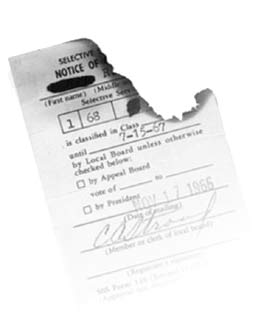![]()
Write us!
socialistviewpoint@pacbell.net
Vietnam, Iraq and the Return of the Draft
By Joaquín Bustelo

There is increasing buzz in ruling class circles about reinstating the draft.
The fact is that Rumfeld’s new military doctrine isn’t working and isn’t likely to. The idea was to offload from the armed forces a lot of logistics and support, reserving soldiers for the actual fighting units.
For that reason, viewed in terms of the number of “grunts” whose primary role is combat, the U.S. army in Iraq right now isn’t that much smaller than in Vietnam, where more than half a million troops were deployed but the big majority were in support, not combat roles. The number in Iraq is manipulated even more because the figure everyone is fixated on is the 135,000 said to be within Iraq’s borders. There are several tens of thousands more in neighboring countries, though.
One way to figure out the actual forces in the Iraqi theater of operations is to get the total CENTCOM manpower and subtract what’s inside Afghanistan. But the number of troops assigned to CENTCOM, which had been a public figure a year ago, seems to be so no longer. An educated guess is something on the order of 200,000-250,000 is the real size of the U.S. Iraqi force, including those in Kuwait, Saudi Arabia, Qatar, offshore on ships and so on.
Right now a lot of the logistics for the units in Iraq are being handled by the corporations. That’s what the four mercenaries who got killed in Fallujah were doing. They were a security detail for the supply convoys to the Marine base. Officially they were described as providing security for food deliveries in the area, but you can be sure they weren’t guarding peasants bringing their goods to market.
If there is no major security threat, then perhaps people like that can deal with bandits and harassment from tiny groups of partisans. But if you’re fighting a well-organized guerrilla force, then a little squad of paramilitaries is likely to get rubbed out, as this one was.
Against the well-organized insurgency that the Iraqi resistance has become, the units on the U.S. side have to operate within a well-structured military force, with intelligence, communications, reserves, air support and a clear chain of command.
These little groups of “security guards” that are being used to escort convoys and depots are just too light in military terms to deal with the kind of situation they’re facing on the ground in Iraq. And they are very expensive, which means that up to 25 percent of the reconstruction money the U.S. is spending in Iraq is now going to pay these security companies.
Moreover, a lot of the company employees that go there aren’t exactly mercenaries. They’re not military adventurers and soldiers of fortune, they’re truck drivers of fortune, so to speak. The private contractors are not going to succeed in hiring and retaining these people if a lot of them are getting killed.
The U.S. clearly needs tens of thousands more troops to secure and operate its lines of communications. According to U.S. sources, there are some 20,000 of these private security forces in Iraq, the second-largest military contingent after what the Pentagon has sent, and almost the equal of all the rest of the coalition (who number 23,000, including the Spanish, Honduran and other contingents that are heading for the exit.)
Right now the administration is hoping a political solution will drop into its lap that will take the steam out of the rebellion. In fact things have been going the other way. The more time goes on, the more civilians U.S. forces kill, the more enemies they make, the more they convince the Iraqis that the only way to get them out of the country is to drive them out.
The rotation of U.S. units makes things worse. The current force in Fallujah—Marines—was openly critical of the way the Army units they replaced in March handled that sensitive area. It was the Marine’s efforts to “straighten out” the situation that led to the uprising that held the Marines on the outskirts of the city throughout most of April.
So, yes, a big push to reinstate the draft is coming. That’s what the logic of the military situation on the ground says. Economic compulsion isn’t enough to get sufficient numbers of troops for what needs to be done, and the U.S. cannot easily afford to simply accept defeat in Iraq, because that would likely mean pulling the plug on a whole series of reactionary U.S. client regimes in the region.
By this time next year reintroduction of the draft will be the big issue, if it hasn’t already been pushed through by President Bush or Kerry.
Write us
socialistviewpoint@pacbell.net